上海英语高级口译资格证书第一阶段考试
上海市英语高级口译岗位资格证书考试
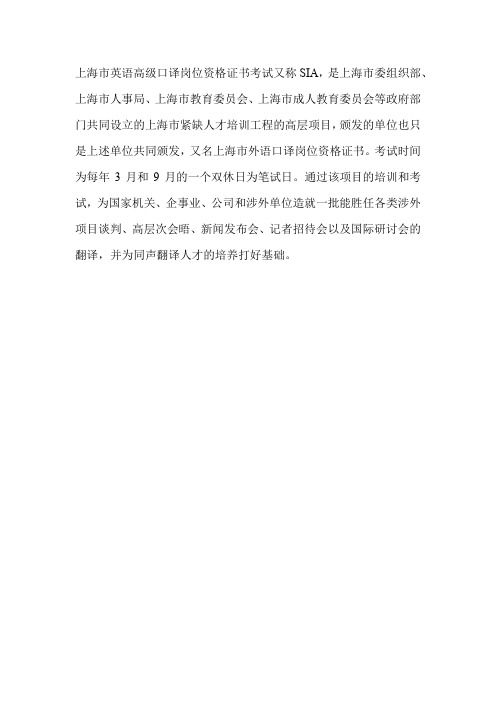
上海市英语高级口译岗位资格证书考试又称SIA,是上海市委组织部、上海市人事局、上海市教育委员会、上海市成人教育委员会等政府部门共同设立的上海市紧缺人才培训工程的高层项目,颁发的单位也只是上述单位共同颁发,又名上海市外语口译岗位资格证书。
考试时间为每年3月和9月的一个双休日为笔试日。
通过该项目的培训和考试,为国家机关、企事业、公司和涉外单位造就一批能胜任各类涉外项目谈判、高层次会晤、新闻发布会、记者招待会以及国际研讨会的翻译,并为同声翻译人才的培养打好基础。
高级口译经验贴

高级口译经验贴韩卿与老师约好,除了考研经验贴外,再为同学们写一篇备考上海市高级口译资格证书的经验贴。
在我之前,我们系几乎没有人参加类似考试,所以这个考试对我来说特别具有挑战性,所有的路自己一路摸爬滚打慢慢走来,感觉甚是不易。
高级口译证书考试分为两阶段,第一阶段为笔试,第二阶段为口试。
两阶段都通过才可以拿到证书。
笔试和口试每年都考2次。
笔试通过者在2年四次内任何一次通过口试,即可拿到证书。
咱们先来说说高级口译的笔试。
高口笔试共300分,其中,听力100分,阅读100分,英汉互译100分。
高口的笔试难度远高于大学英语六级难度,真要比较的话,其难度近似专业八级,但因为很多题型并不一样,可比性不是很大。
具体的考试安排如下:第一阶段综合笔试共分六部分。
第一部分:听力;第二部分:阅读(1);第三部分:翻译(英译汉);第四部分:听译;第五部分:阅读(2);第六部分:翻译(汉译英)。
每部分考试时间为30分钟,总考试时间为180分钟,中间(即第三部分结束后)休息10分钟。
每部分考分分配为50分,六部分总分300分,合格分为180分。
报名时间:每年6月20-26日,12月20日-26日考试时间:每年3月和9月的一个双休日为笔试日8:00进场,考试时间:8:30——11:45考试流程:时间考试流程8:00 考生可以入场8:10 考官宣读考生须知,并发布上半场考试试卷及答题纸(试卷第一、二、三部分);考生调试收音机频道,确认收听频率8:30 考试正式开始,电台开始播放录音8:30—9:00 考生做第一部分听力试题,听力考察时间为30分钟。
9:00—10:00 考生开始做试卷第二和第三部分。
原则时间划分是阅读30分钟,翻译30分钟10:00 上半场考试结束(以铃声为准)10:00—10:10 考间休息,原则上考生原地休息;考官发放下半场考试记录纸10:10—10:15 下半场考试开始(以铃声为准)考生调试频道10:15 电台开始播放Section 4 的录音Section4 的录音播放完后,发放Section4、Section5和Section6的试卷和答题纸10:45—11:45 听力结束,考生开始做下半场考试Section5和Section6的试题11:45 全部考试结束以上为考试的具体安排。
上海中高级口译考试全解析
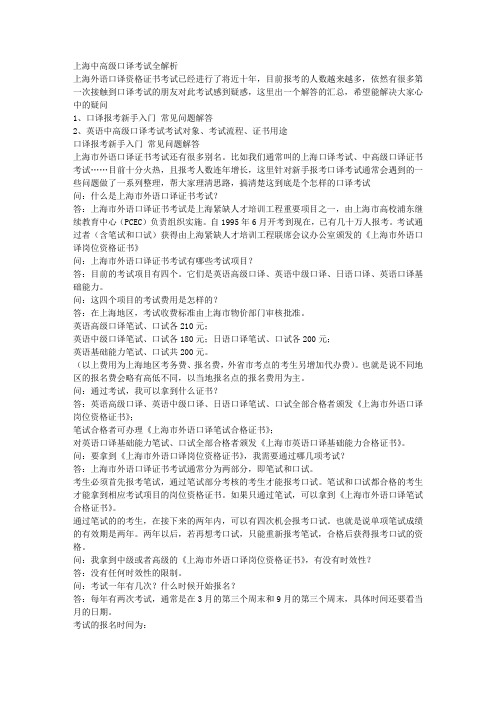
上海中高级口译考试全解析上海外语口译资格证书考试已经进行了将近十年,目前报考的人数越来越多,依然有很多第一次接触到口译考试的朋友对此考试感到疑惑,这里出一个解答的汇总,希望能解决大家心中的疑问1、口译报考新手入门常见问题解答2、英语中高级口译考试考试对象、考试流程、证书用途口译报考新手入门常见问题解答上海市外语口译证书考试还有很多别名。
比如我们通常叫的上海口译考试、中高级口译证书考试……目前十分火热,且报考人数连年增长,这里针对新手报考口译考试通常会遇到的一些问题做了一系列整理,帮大家理清思路,搞清楚这到底是个怎样的口译考试问:什么是上海市外语口译证书考试?答:上海市外语口译证书考试是上海紧缺人才培训工程重要项目之一,由上海市高校浦东继续教育中心(PCEC)负责组织实施。
自1995年6月开考到现在,已有几十万人报考。
考试通过者(含笔试和口试)获得由上海紧缺人才培训工程联席会议办公室颁发的《上海市外语口译岗位资格证书》问:上海市外语口译证书考试有哪些考试项目?答:目前的考试项目有四个。
它们是英语高级口译、英语中级口译、日语口译、英语口译基础能力。
问:这四个项目的考试费用是怎样的?答:在上海地区,考试收费标准由上海市物价部门审核批准。
英语高级口译笔试、口试各210元;英语中级口译笔试、口试各180元;日语口译笔试、口试各200元;英语基础能力笔试、口试共200元。
(以上费用为上海地区考务费、报名费,外省市考点的考生另增加代办费)。
也就是说不同地区的报名费会略有高低不同,以当地报名点的报名费用为主。
问:通过考试,我可以拿到什么证书?答:英语高级口译、英语中级口译、日语口译笔试、口试全部合格者颁发《上海市外语口译岗位资格证书》;笔试合格者可办理《上海市外语口译笔试合格证书》;对英语口译基础能力笔试、口试全部合格者颁发《上海市英语口译基础能力合格证书》。
问:要拿到《上海市外语口译岗位资格证书》,我需要通过哪几项考试?答:上海市外语口译证书考试通常分为两部分,即笔试和口试。
上海市英语高级口译岗位资格证书考试大纲
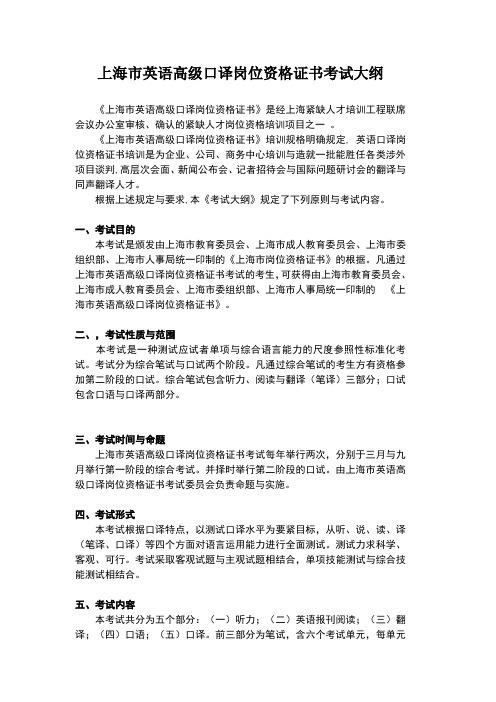
上海市英语高级口译岗位资格证书考试大纲《上海市英语高级口译岗位资格证书》是经上海紧缺人才培训工程联席会议办公室审核、确认的紧缺人才岗位资格培训项目之一。
《上海市英语高级口译岗位资格证书》培训规格明确规定, 英语口译岗位资格证书培训是为企业、公司、商务中心培训与造就一批能胜任各类涉外项目谈判,高层次会面、新闻公布会、记者招待会与国际问题研讨会的翻译与同声翻译人才。
根据上述规定与要求,本《考试大纲》规定了下列原则与考试内容。
一、考试目的本考试是颁发由上海市教育委员会、上海市成人教育委员会、上海市委组织部、上海市人事局统一印制的《上海市岗位资格证书》的根据。
凡通过上海市英语高级口译岗位资格证书考试的考生,可获得由上海市教育委员会、上海市成人教育委员会、上海市委组织部、上海市人事局统一印制的《上海市英语高级口译岗位资格证书》。
二、,考试性质与范围本考试是一种测试应试者单项与综合语言能力的尺度参照性标准化考试。
考试分为综合笔试与口试两个阶段。
凡通过综合笔试的考生方有资格参加第二阶段的口试。
综合笔试包含听力、阅读与翻译(笔译)三部分;口试包含口语与口译两部分。
三、考试时间与命题上海市英语高级口译岗位资格证书考试每年举行两次,分别于三月与九月举行第一阶段的综合考试。
并择时举行第二阶段的口试。
由上海市英语高级口译岗位资格证书考试委员会负责命题与实施。
四、考试形式本考试根据口译特点,以测试口译水平为要紧目标,从听、说、读、译(笔译、口译)等四个方面对语言运用能力进行全面测试。
测试力求科学、客观、可行。
考试采取客观试题与主观试题相结合,单项技能测试与综合技能测试相结合。
五、考试内容本考试共分为五个部分:(一)听力;(二)英语报刊阅读;(三)翻译;(四)口语;(五)口译。
前三部分为笔试,含六个考试单元,每单元30分钟,共需时180分钟;后两部分为口试,举行笔试后再择时单独进行。
1、听力听力测试分为四部分:听写、听力懂得、笔记与听译。
2023年3月上海市高级口译资格第一阶段笔试真题试卷及答案
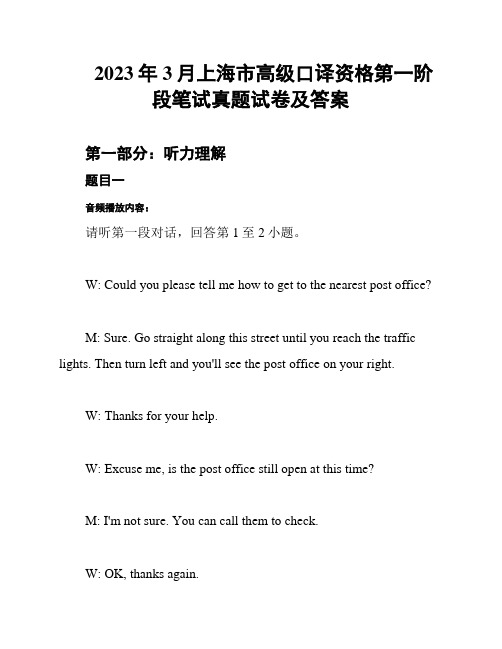
2023年3月上海市高级口译资格第一阶段笔试真题试卷及答案第一部分:听力理解题目一音频播放内容:请听第一段对话,回答第1至2小题。
W: Could you please tell me how to get to the nearest post office?M: Sure. Go straight along this street until you reach the traffic lights. Then turn left and you'll see the post office on your right.W: Thanks for your help.W: Excuse me, is the post office still open at this time?M: I'm not sure. You can call them to check.W: OK, thanks again.M: No problem.问题:1. Where is the nearest post office?2. How can the woman confirm if the post office is still open?答案:1. On the right, after turning left at the traffic lights.2. By calling the post office.题目二音频播放内容:请听第二段对话,回答第3至4小题。
W: Have you seen the weather forecast for tomorrow?M: No, I haven't. What did it say?W: It said it'll be sunny in the morning, but it might rain in the afternoon.M: I hope it stays sunny. I have plans for a picnic.W: Let's keep an eye on the weather. We can always reschedule if needed.M: That's true. Thanks for letting me know.M: Anyway, do you want to go get some ice cream later?W: Sure, that sounds great!问题:3. What does the weather forecast say about tomorrow?4. What are the speakers planning to do if the weather changes?答案:3. Sunny in the morning, but possibly rain in the afternoon.4. They will reschedule their picnic plans if needed.第二部分:阅读理解文章一The Benefits of Regular ExerciseRegular exercise is essential for maintaining good physical and mental health. Here are some of the key benefits:2. Disease Prevention: Regular physical activity reduces the risk of developing chronic diseases such as heart disease, high blood pressure, and diabetes.3. Mental Well-being: Exercise releases endorphins, which are known as the "feel-good" hormones. It helps reduce stress, anxiety, and depression, promoting better mental health.4. Improved Sleep: People who exercise regularly tend to have better sleep quality, allowing them to feel more rested and energized during the day.5. Increased Energy Levels: Engaging in physical activity boosts energy levels and reduces fatigue. Regular exercise improves overall stamina and endurance.In conclusion, incorporating regular exercise into one's lifestyle brings numerous benefits to both physical and mental well-being. It is important to make time for exercise and prioritize it as a part of a healthy routine.问题:5. What is one of the benefits of regular exercise mentioned in the passage?6. What are endorphins known for?答案:5. Weight management and prevention of obesity.6. Endorphins are known as the "feel-good" hormones.文章二The Impact of Air Pollution on HealthAir pollution is a significant environmental issue that poses risks to human health. Here are some of the ways air pollution can affect our well-being:1. Respiratory Problems: Exposure to pollutants in the air can lead to respiratory issues, such as asthma and bronchitis. Long-term exposure can cause permanent lung damage.2. Cardiovascular Diseases: Air pollution has been linked to an increased risk of heart attacks, strokes, and other cardiovascular diseases. Fine particles in the air can enter the bloodstream and affect the heart and blood vessels.4. Premature Death: Studies have shown that long-term exposure to air pollution can shorten life expectancy. The pollutants in the air contribute to various health conditions that can lead to premature death.In order to protect our health, it is crucial to take measures to reduce air pollution and improve air quality.问题:7. What are some health problems associated with air pollution according to the passage?8. What can be done to protect our health from air pollution?答案:7. Respiratory problems, cardiovascular diseases, allergies and irritations, and premature death.8. Measures should be taken to reduce air pollution and improve air quality.。
上海外语口译证书考试报名条件

上海外语口译证书考试报名条件一、上海外语口译证书考试简介上海外语口译证书考试(Shanghai International interpretation Certification Examination,简称SICE)是由上海外国语大学主办的一项外语水平考试。
该考试旨在评估考生的外语口语和听力能力,为社会各类人士提供客观、公正的外语能力评价。
持有该证书的人员可在国内外企事业单位、政府部门等领域担任口译工作。
二、报名条件概述根据我国相关规定,报名参加上海外语口译证书考试的人员需具备以下条件:1.遵守中华人民共和国宪法和法律。
2.具有良好品德和职业素养。
3.具有相应的外语水平。
三、不同级别证书的报名条件SICE考试分为初级、中级和高级三个级别。
不同级别证书的报名条件如下:1.初级证书:a.高中及以上学历。
b.外语水平:具备基础词汇量和简单语法结构。
2.中级证书:a.大专及以上学历。
b.外语水平:具备中等词汇量和基本语法结构。
3.高级证书:a.本科及以上学历。
b.外语水平:具备较高级词汇量和复杂语法结构。
四、特殊人群报名条件1.在校大学生:a.遵守学校纪律,无作弊、违规行为。
b.具备相应的外语水平。
2.社会考生:a.具备相应学历和外语水平。
b.具有良好的道德品质和职业素养。
五、报名材料及流程1.身份证原件及复印件。
2.学历证书原件及复印件。
3.外语水平证明原件及复印件。
4.两寸免冠近照若干张。
5.填写报名表并缴纳报名费。
6.参加考试。
持有上海外语口译证书的人员将在职场竞争中更具优势,提高自身的外语能力。
上海英语高级口译资格证书第一阶段考试E1参考答案
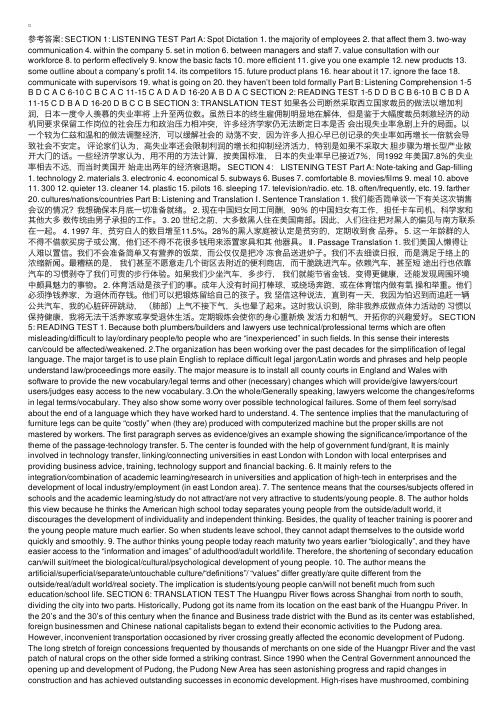
参考答案: SECTION 1: LISTENING TEST Part A: Spot Dictation 1. the majority of employees 2. that affect them 3. two-way communication 4. within the company 5. set in motion 6. between managers and staff 7. value consultation with our workforce 8. to perform effectively 9. know the basic facts 10. more efficient 11. give you one example 12. new products 13. some outline about a company’s profit 14. its competitors 15. future product plans 16. hear about it 17. ignore the face 18. communicate with supervisors 19. what is going on 20. they haven’t been told formally Part B: Listening Comprehension 1-5 B D C A C 6-10 C B C A C 11-15 C A D A D 16-20 A B D A C SECTION 2: READING TEST 1-5 D D B C B 6-10 B C B D A 11-15 C D B A D 16-20 D B C C B SECTION 3: TRANSLATION TEST 如果各公司断然采取西⽴国家裁员的做法以增加利润,⽇本⼀度令⼈羡慕的失业率将上升⾄两位数。
2000_9上海市英语高级口译资格证书第一阶段考试[参考答案]
![2000_9上海市英语高级口译资格证书第一阶段考试[参考答案]](https://img.taocdn.com/s3/m/83b94a275901020207409c7a.png)
2000.9上海市英语高级口译资格证书第一阶段考试参考答案:SECTION 1: LISTENING TESTPART A: Spot Dictation1. cross border mergers 11. utility companies2. have been removed 12. more environmentally sensitive3. food and drink 13. With water companies4. culturally bound 14. a lot of privatizations5. eating and drinking habits 15. English and German banks6. particularly aggressive 16. that was unheard of7. Spanish and Italian products 17. protective attitude8. The reverse is not true 18. been applied across Europe9. in the drinks industry 19. the internationalization10. in acquiring companies 20. more controls in the futurePART B: Listening Comprehension1-5 D B C A B 6-10 C A D C A11-15 B C BB C 16-20 D A C D CSECTION 2: READING TEST1-5 C B D B C 6-10 D B A C D11-15 D B CC A 16-20 C A D A BSECTION 3: TRANSLATION TEST第三次工业革命最大的问题既容易说明,又难以解决。
三种翻译资格证书比较

阅读教程(周道宏、瞿晓华编着)
翻译教程(张鸿成编着)
口语教程(陆国华、黄秋萍编着)
口译教程(钱力奋编着)
考试时间
自05年起,二级、三级英语翻译专业资格(水平)考试暂定每年举行2次,考试日期原则定为5月份最后一周的周六、周日和11月份第二周的周六、周日;其他语种各级别考试每年举行1次,为5月份最后的一周的周六、周日,与英语考试日期一致。
考试合格
不设通过率
综合能力和实务两科同时达到60分算合格
不设通过率
全国外语翻译证书考试的各个证书考试是各自独立的。通过任何一个证书考试都可获得相应的证书。口译和笔译均采用A、B、C、D四级记分法,口译各部分都在B(含B)以上为合格,除高级口译外,通过录音考试就可获得证书,通过高级口译录音考试的考生还要参加面试,面试合格才能获得证书。笔译试卷中各部分都在B(含B)以上为合格。考试合格就可获得证书。
日语口译和笔译考试在北京、上海、大连、山东(济南、青岛)、天津、重庆、福建、广东、广州、浙江、江苏、吉林、黑龙江、湖北、武汉;
俄语、西班牙语、阿拉伯语口译和笔译考试、英语同声传译考试只在北京进行。
2004年考点设置:
大连外国语学院、北京语言大学、北京外国语大学、西安外国语学院考试管理中心、上海外国语大学、武汉大学师资培训中心、四川大学出国人员培训部、四川外语学院、广东外语外贸大学考试中心、黑龙江大学、吉林大学、内蒙古工业大学、山西大学、天津外国语学院、新疆大学外国语学院、兰州大学、郑州大学、解放军外国语学院、湖南大学教务处、山东师范大学山东省外语培训中心、中国海洋大学、南京大学、江西师范大学、中国科技大学、浙江省自考办、云南师范大学外语学院、广西大学外国语学院、河北师范大学、宁夏大学、厦门大学、辽宁教育国际交流服务中心、青海省小岛文化教育发展基地、天津商学院、中山大学外国语学院、深圳市赣冠职业培训中心、福建省自考办、海南考试局
上海市英语高级口译岗位资格证书
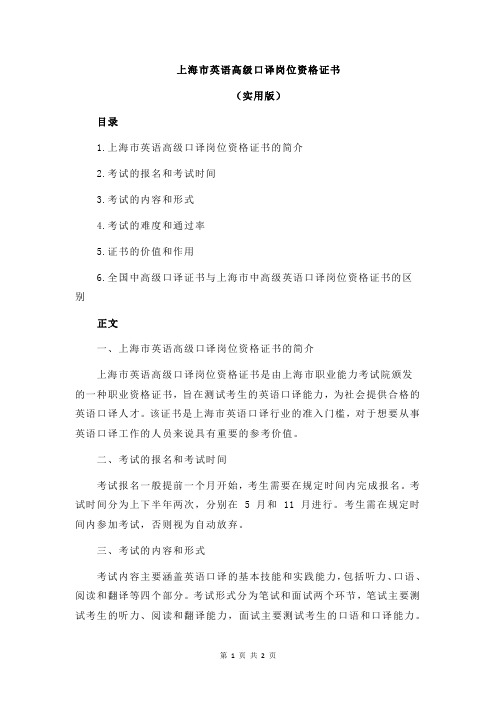
上海市英语高级口译岗位资格证书(实用版)目录1.上海市英语高级口译岗位资格证书的简介2.考试的报名和考试时间3.考试的内容和形式4.考试的难度和通过率5.证书的价值和作用6.全国中高级口译证书与上海市中高级英语口译岗位资格证书的区别正文一、上海市英语高级口译岗位资格证书的简介上海市英语高级口译岗位资格证书是由上海市职业能力考试院颁发的一种职业资格证书,旨在测试考生的英语口译能力,为社会提供合格的英语口译人才。
该证书是上海市英语口译行业的准入门槛,对于想要从事英语口译工作的人员来说具有重要的参考价值。
二、考试的报名和考试时间考试报名一般提前一个月开始,考生需要在规定时间内完成报名。
考试时间分为上下半年两次,分别在 5 月和 11 月进行。
考生需在规定时间内参加考试,否则视为自动放弃。
三、考试的内容和形式考试内容主要涵盖英语口译的基本技能和实践能力,包括听力、口语、阅读和翻译等四个部分。
考试形式分为笔试和面试两个环节,笔试主要测试考生的听力、阅读和翻译能力,面试主要测试考生的口语和口译能力。
四、考试的难度和通过率上海市英语高级口译岗位资格证书考试难度较高,要求考生具备较高的英语水平和口译能力。
通过率因年度不同而有所变化,一般在 20% 至30% 之间。
五、证书的价值和作用该证书是上海市英语口译行业的准入门槛,对于想要从事英语口译工作的人员来说具有重要的参考价值。
持有该证书的人员,在求职、晋升和薪资方面都具有一定的优势。
同时,该证书也是国内外企事业单位招聘英语口译人才的重要依据。
六、全国中高级口译证书与上海市中高级英语口译岗位资格证书的区别全国中高级口译证书和上海市中高级英语口译岗位资格证书在考试性质、颁发机构和证书价值等方面都存在一定的区别。
全国中高级口译证书是全国范围内的证书,颁发机构为国家外国专家局,主要用于评估非英语专业人员的英语口译能力。
而上海市中高级英语口译岗位资格证书是地方性的证书,颁发机构为上海市职业能力考试院,主要用于评估上海市英语口译人才的口译能力。
上海高级口译英语笔试真题
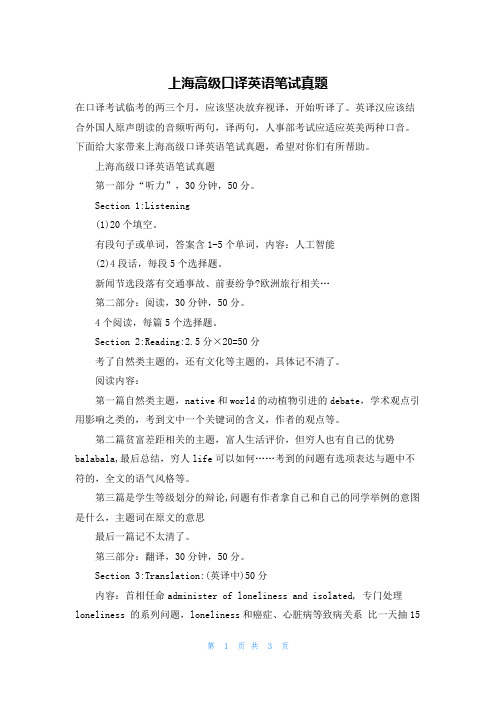
上海高级口译英语笔试真题在口译考试临考的两三个月,应该坚决放弃视译,开始听译了。
英译汉应该结合外国人原声朗读的音频听两句,译两句,人事部考试应适应英美两种口音。
下面给大家带来上海高级口译英语笔试真题,希望对你们有所帮助。
上海高级口译英语笔试真题第一部分“听力”,30分钟,50分。
Section 1:Listening(1)20个填空。
有段句子或单词,答案含1-5个单词,内容:人工智能(2)4段话,每段5个选择题。
新闻节选段落有交通事故、前妻纷争?欧洲旅行相关…第二部分:阅读,30分钟,50分。
4个阅读,每篇5个选择题。
Section 2:Reading:2.5分×20=50分考了自然类主题的,还有文化等主题的,具体记不清了。
阅读内容:第一篇自然类主题,native和world的动植物引进的debate,学术观点引用影响之类的,考到文中一个关键词的含义,作者的观点等。
第二篇贫富差距相关的主题,富人生活评价,但穷人也有自己的优势balabala,最后总结,穷人life可以如何……考到的问题有选项表达与题中不符的,全文的语气风格等。
第三篇是学生等级划分的辩论,问题有作者拿自己和自己的同学举例的意图是什么,主题词在原文的意思最后一篇记不太清了。
第三部分:翻译,30分钟,50分。
Section 3:Translation:(英译中)50分内容:首相任命administer of loneliness and isolated, 专门处理loneliness 的系列问题,loneliness和癌症、心脏病等致病关系比一天抽15根雪茄还严重,还有loneliness 的影响、危害和治理等。
补充:通讯技术的发展、social media等原因,提到了facebook和instagram等社交平台,Facebook原本宣称自己是为了改善社交状态的,但结果反而加剧了社交平台loneliness and isolated.【中间休息15分钟后接着考】第四部分:听力,30分钟,50分。
199803高译答案及听力原文

1998.3上海市英语高级口译资格证书第一阶段考试参考答案:SECTION 1:LISTENING TESTPart A: Spot Dictation1. formal committee meetings2. several reasons3. feel more committed to4. imaginative and informed decisions5. have drawbacks6. more group pressure7. seem to be ideal sizes 8. from the floor9. the style of its leader 10. let everyone speak11. take a vote 12. seconded and discussed13. a consensus of members 14. circulated in advance15. a list of points 16. is to speed up17. in logical order 18. the meeting’s function19. structured and planned 20. chance conversationsPart B: Listening comprehension1-5 B D C C B 6-10 C C C D B11-15 D B A C B 16-20 D A C B DSECTION 2: READING TEST1-5 B C D A C 6-10 D B B D A11-15 C B A A D 16-20 D B A C CSECTION 3: TRANSLATION TEST“责任”、“荣誉”和“国家”这三个神圣的词庄严地责成你们应成为怎样的人,能成为怎样的人,将成为怎样的人。
这三个词要求你们在失去勇气时鼓起勇气,在失去信念时恢复信念,在失去希望时产生希望。
199809高译答案及听力原文
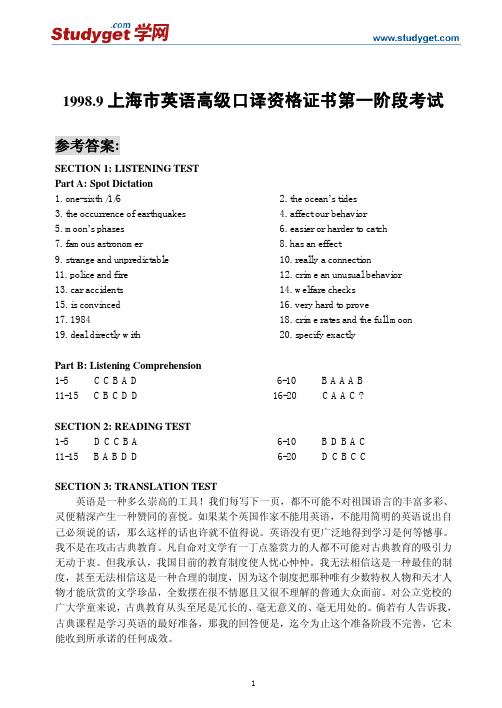
1998.9上海市英语高级口译资格证书第一阶段考试参考答案:SECTION 1: LISTENING TESTPart A: Spot Dictation1. one-sixth /1/62. the ocean’s tides3. the occurrence of earthquakes4. affect our behavior5. moon’s phases6. easier or harder to catch7. famous astronomer 8. has an effect9. strange and unpredictable 10. really a connection11. police and fire 12. crime an unusual behavior13. car accidents 14. welfare checks15. is convinced 16. very hard to prove17. 1984 18. crime rates and the full moon19. deal directly with 20. specify exactlyPart B: Listening Comprehension1-5 C C B A D 6-10 B A A A B11-15 C B C D D 16-20 C A A C ?SECTION 2: READING TEST1-5 D C C B A 6-10 B D B A C11-15 B A B D D 6-20 D C B C CSECTION 3: TRANSLATION TEST英语是一种多么崇高的工具!我们每写下一页,都不可能不对祖国语言的丰富多彩、灵便精深产生一种赞同的喜悦。
如果某个英国作家不能用英语,不能用简明的英语说出自己必须说的话,那么这样的话也许就不值得说。
英语没有更广泛地得到学习是何等憾事。
上海市英语高级口译岗位资格证书考试第一阶段试题及答案

上海市英语高级口译岗位资格证书考试第一阶段试题及答案上海市英语高级口译岗位资格证书考试第一阶段试题(06.9) SECTION1:LISTENING TEST(30minutes)Part A:Spot Dictation Directions:In this part of the test, you will hear a passage and read the same passage with blanks in it.Fill in each of the blanks with the world or words you have heard on the tape.Write your answer in the corresponding space in your ANSWER BOOKLET.Remember you will hear the passage ONLY ONCE.Play is very important for humans from birth to death.Play is not meant to be just for children.It is a form of___________(1)that can tap into your creativity,and can allow you the chance to find your inner child and the inner child of others.I have collected the___________(2)of play here.Play can stimulate you___________(3).It can go against all the rules,and change the same___________(4).Walt Disney was devoted to play,and his willingness to___________ (5)changed the world of entertainment.The next time you are stuck in a___________(6)way of life,pull out a box of color pencils,modeling clay,glue and scissors,and___________(7)and break free.You will be amazed at the way your thinking___________(8).Playing can bring greater joy into your life.What do you think the world would be like-if___________(9)each day in play?I bet just asking you this question has___________(10).Play creates laughter,joy,entertainment, ___________(11).Starting today,try to get30minutes each day to engage in some form of play,and ___________(12)rise!Play is known___________(13). Studies show that,as humans,play is part of our nature. We have the need to play because it is instinctive and ___________(14).With regular play,our problem-solving and___________(15)will be in much better shape to handle this complex world,and we are much more likely to choose ___________(16)as they arise.It creates laughter and freedom that can instantly reduce stress and__________ (17)to our daily living.Play can___________(18), curiosity,and creativity.Research shows that play is both a‘hands-on’and‘minds-on’learning process.It produces a deeper,___________(19)of the world and its possibilities.We begin giving meaning to life through story making,and playing out___________(20).Part B:Listening Comprehension Directions:In this part of the test there will be some short talks and conversations.After each one,you will be asked some questions.The talks,conversations and questions will be spoken ONLY ONCE.Now listen carefully and choose the right answer to each question you have heard and write the letter of the answer you have chosen in the corresponding space in your ANSWER BOOKLET.Questions1to5are based on the following conversation.1.(A)in Cherry Blossoms Village ninety of the residents are over85years old.(B)In the United States,there are twice as many centenarians as there were ten years ago.(C)All the people studied by these scientists from Georgia live in institutions for the elderly.(D)Almost all the residents in Cherry Blossoms Village have unusual hobbies.2.(A)Whether the centenarians can live independently in small apartments.(B)Whether it is feasible to establish a village for the”oldest old”people.(C)What percentage of the population are centenarians inthe state of Georgia.(D)What the real secrets are to becoming an active and healthy100-year-old.3.(A)Diet,optimism,activity or mobility,and genetics.(B)Optimism,commitment to interesting things,activity or mobility,and adaptability to loss.(C)The strength to adapt to loss,diet,exercise,and genetics.(D)Diet,exercise,commitment to something they were interested in,and genetics.4.(A)The centenarians had a high calorie and fat intake.(B)The centenarians basically eat something different.(C)The centenarians eat a low-fat and low-calorie, unprocessed food diet.(D)The centenarians eat spicy food,drink whiskey,and have sweet pork every day.5.(A)Work hard.(B)Stay busy.(C)Stick to a balanced diet.(D)Always find something to laugh about.Questions6to10are based on the following news.6.(A)Global temperatures rose by3degrees in the20thcentury.(B)Global warming may spread disease that could kill a lot of people in Africa.(C)Developed countries no longer depend on fossil fuels for transport and power.(D)The impact of the global warming will be radically reduced by2050.7.(A)Taking bribes.(B)Creating a leadership vacuum at the country’s top car maker.(C)Misusing company funds for personal spending.(D)Offering cash for political favors.8.(A)The nation has raised alert status to the highest level and thousands of people have moved to safety. (B)The eruption of Mount Merapi has been the worst in Indonesia over the past two decades.(C)All residents in the region ten kilometers from the base of the mountain have evacuated.(D)The eruption process was a sudden burst and has caused extensive damage and heavy casualty.9.(A)6to7.(B)8to10.(C)11to16.(D)17to25.10.(A)Curbing high-level corruption.(B)Fighting organized crime.(C)Investigating convictions of criminals.(D)Surveying the threats to national security. Questions11to15are based on the following interview.11.(A)A wine taster.(B)A master water taster.(C)The host of the show.(D)The engineer who works on the water treatment plant.12.(A)Berkeley Springs.(B)Santa Barbara.(C)Atlantic City.(D)Sacramento.13.(A)Being saucy and piquant.(B)Tasting sweet(C)A certain amount of minerals.(D)An absence of taste. 14.(A)Looking—smelling—tasting.(B)Tasting—smelling—looking.(C)Smelling—looking—tasting.(D)Tasting—looking—smelling.15.(A)Bathing.(B)Boiling pasta in.(C)Swimming.(D) Making tea.Questions16to20are based on the following talk. 16.(A)Enhance reading and math skills.(B)Increase the students’appreciation of nature.(C)Improve math,but not reading skills.(D)Develop reading,but not math skills.17.(A)To help the students appreciate the arts.(B)To make the students’educatio n more well-rounded.(C)To investigate the impact of arts training.(D)To enhance the students’math skills.18.(A)Once weekly.(B)Twice weekly.(C)Once a month.(D)Twice a month.19.(A)Six months.(B)Seven months.(C)Eight months.(D) Nine months.20.(A)The children’s attitude.(B)The children’s test scores.(C)Both the children’s attitude and test scores.(D)Both the teachers’and the children’s attitude. SECTION2:READING TEST(30minutes)Directions:In this section you will read several passages. Each one is followed by several questions about it.You are to choose ONE best answer,(A),(B),(C)or(D),to each question.Answer all the questions following each passage on the basis of what is stated orimplied in that passage and write the letter of the answer you have chosen in thecorresponding space in your ANSWER BOOKLET.Questions1—5Anyone who doubts that children are born with a healthy amount of ambition need spend only a few minutes with ababy eagerly learning to walk or a headstrong toddler starting to talk.No matter how many times the little ones stumble in their initial efforts,most keep on trying, determined to master their amazing new skill.It is only several years later,around the start of middle or junior high school,many psychologists and teachers agree,that a good number of kids seem to lose their natural drive to succeed and end up joining the ranks of underachievers. For the parents of such kids,whose own ambition is often inextricably tied to their children’s su ccess,it can be a bewildering,painful experience.So it’s no wonder some parents find themselves hoping that,just maybe, ambition can be taught like any other subject at school. It’s not quite that simple.”Kids can be given the opportunities to become passionate about a subject or activity,but they can’t be forced,”says Jacquelynne Eccles,a psychology professor at the University of Michigan,who led a landmark,25-year study examining what motivated first-and seventh-grades in three school districts.Even so,a growing number of educators and psychologists do believe it is possible to unearth ambition in students who don’t seem to have much.Theysay that by instilling confidence,encouraging some risk taking,being accepting of failure and expanding the areas in which children may be successful,both parents and teachers can reignite that innate desire to achieve. Figuring out why the fire went out is the first step. Assuming that a kid doesn’t suffer froman emotional or learning disability,or isn’t involved in some family crisis at home,manyeducators attribute a sudden lack of motivation to a fear of failure or peer pressure thatconveys the message that doing well academically somehow isn’t cool.”Kids get so caught up in the moment-to-moment issue of will they look smart or dumb,and it blocks them from thinking about the long term,”says Carol Dweck,a psychology professor at Stanford.”You have to teach them that they are in charge of their intellectual growth.”Over the past couple of years,Dweck has helped run an experimental workshop with New York City public school seventh-graders to do just that.Dubbed Brainology,the unorthodox approach uses basic neuroscience to teach kids how the brain works and how it can continue to develop throughou t life.”The message is that everything iswithin the kids’control,that their intelligence is malleable,”says Lisa Blackwell,a research scientist at Columbia University who has worked with Dweck to develop and run the program,which has helped increase the students’interest in school and turned around their declining math grades.More than any teacher or workshop, Blackwell says,”parents can play a critical role in conveying this message to their children by praising their effort,strategy and progres s rather than emphasizing their‘smartness’or praising high performance alone. Most of all,parents should let their kids know that mistakes are a part of learning.”Some experts say our education system,with its strong emphasis on testing and rigid separation of students into different levels of ability,also bears blame for the disappearance of drive in some kids.”These programs shut down the motivation of all kids who aren’t considered gifted and talented. They destroy their confidence,”says Jeff How ard,a social psychologist and president of the Efficacy Institute,a Boston-area organization that works with teachers and parents in school districts around the country to help improve children’sacademic performance.Howard and other educators say it’s important to expose kids to aworld beyond homework and tests,through volunteer work,sports,hobbies and other extracurricular activities.”The crux of the issue is that many students experience education as irrelevant to their life goals and ambitions,”says Michael Nakkual,a Harvard education professor who runs a Boston-area mentoring program called Project IF(Inventing the Future),which works to get low-income underachievers in touch with their aspirations.The key to getting kids to aim higher at school is to disabuse them of the notion that classwork is irrelevant,to show them how doing well at school can actually help them fulfill their dreams beyond it.Like any ambitious toddler,they need to understand that you have to learn to walk before you can run.1.Which of the following best expresses the main idea of the first paragraph?(A)Children are born with a kind of healthy ambition.(B)How a baby learns to walk and talk.(C)Ambition can be taught like other subjects at school.(D)Some teenage children lose their drive to succeed.2.According to some educators and psychologists,all ofthe following would be helpful to cultivate students’ambition to succeed EXCEPT________.(A)stimulating them to build up self-confidence(B)cultivating the attitude of risk taking(C)enlarging the areas for children to succeed(D)making them understand their family crisis3.What is the message that peer pressure conveys to children?(A)A sudden lack of motivation is attributed to the student’s failure.(B)Book knowledge is not as important as practical experience.(C)Looking smart is more important for young people at school.(D)To achieve academic excellence should not be treated as the top priority.4.The word”malleable”in the clause”that their intelligence is malleable,”(para.3)most probably means capable of being________.(A)altered and developed(B)blocked and impaired(C)sharpened and advanced(D)replaced and transplanted5.The expression”to disabuse them of the notion”(para.4) can be paraphrased as________.(A)to free them of the idea(B)to help them understand the idea(C)to imbue them with the notion(D)to inform them of the conceptQuestions6—10Civil-liberties advocates reeling from the recent revelations on surveillance had something else to worry about last week:the privacy of the billions of search queries made on sites like Google,AOL,Yahoo and Microsoft.As part of a long-running court case,the government has asked those companies to turn over i nformation on its users’search behavior.All but Google have handed over data,and now the Department of Justice has moved to compel the search giant to turn over the goods. What makes this case different is that the intended use of the information is not related tonational security,but the government’s continuing attempt to police Internet pornography.In1998,Congress passed the Child Online Protection Act (COPA),but courts have blocked its implementation due toFirst Amendment concerns.In its appeal,the DOJ wants to prove how easy it is to inadvertently stumble upon pore. In order to conduct a controlled experiment—to be performed by a UC Berkeley professor of statistics—the DOJ wants to use a large sample of actual search terms from the different search engines.It would then use those terms to do its own searches,employing the different kinds of filters each search engine offers,in an attempt to quantify how often”material that is harmful to minors”might appear.Google contends that since it is not a party to the case,the government has not right to demand its proprietary information to perform its test.”We intend to resist their motion vigorously,”said Google attorney Nicole Wong.DOJ spokesperson Charles Miller says that the government is requesting only the actual search terms,and not anything that would link the queries to those who made them.(The DOJ is also demanding a list of a million Web sites that Google indexes to determine the degree to which objectionable sites are searched.)Originally,the government asked for a treasure trove of all searches made in June and July;the request has been scaled back to one week’s worth of search queries.One oddity about the DOJ’s strategy is that the experiment could conceivably sink its own case.If the built-in filters that each search engine provides are effective in blocking porn sites,the government will have wound up proving what the opposition has said all along—you don’t need to suppress speech to protect minors on the Net.”We think that our filtering technology does a good job protecting minors from inadvertently seeing adult content,”says Ramez Naam,group program manager of MSN Search. Though the government intends to use these data specifically for its COPA-related test,it’s possible that the information could lead to further investigations and, perhaps,subpoenas to find out who was doing the searching. What if certain search terms indicated that people were contemplating terrorist actions or other criminal activities?Says the DOJ’s Miller,”I’m assuming that if something raised alarms,we would hand it over to the proper authorities.”Privacy advocates fear that if the government request is upheld,it will open the door to further government examination of search behavior.One solution would be for Google to stop storing the information,but the company hopes to eventually use thepersonal information of consenting customers to improve search performance.”Search is a window into people’s personalities,”says Kurt Opsahl,an El ectronic Frontier Foundation attorney.”They should be able to take advantage of the Internet without worrying about Big Brother looking over their shoulders.”6.When the American government asked Google,AOL,Yahoo and Microsoft to turn over information on its users’search behavior,the major intention is_________.(A)to protect national security(B)to help protect personal freedom(C)to monitor Internet pornography(D)to implement the Child Online Protection Act7.Google refused to turn over”its proprietary information”(para.2)required by DOJ as it believes that ________.(A)it is not involved in the court case(B)users’privacy is most important(C)the government has violated the First Amendment(D)search terms is the company’s busin ess secret8.The phrase”scaled back to”in the sentence”the request has been scaled back to one week’s worth of searchqueries”(para.3)can be replaced by_________.(A)maximized to(B)minimized to(C)returned to(D)reduced to9.In the sentenc e”One oddity about the DOJ’s strategy is that the experiment could conceivably sink its own case.”(para.4),the expression”sink its own case”most probably means that_________.(A)counterattack the opposition(B)lead to blocking of porn sites(C)provide evidence to disprove the case(D)give full ground to support the case10.When Kurt Opsahl says that”They should be able to take advantage of the Internet without worrying about Big Brother looking over their shoulders.”(para.5),the expression”Big Brother”is used to refer to_________.(A)a friend or relative showing much concern(B)a colleague who is much more experienced(C)a dominating and all-powerful ruling power(D)a benevolent and democratic organizationQuestions11—15On New Y ear’s Day,50,000inmates in Kenyan jails went without lunch.This was not somemass hunger strike to highlight poor living conditions. It was an extraordinary humanitarian gesture:the money that would have been spent on their lunches went to the charity Food Aid to help feed an estimated 3.5million Kenyans who,because of a severe drought,are threatened with starvation.The drought is big news in Africa, affecting huge areas of east Africa and the Horn.If you are reading this in the west,however,you may not be aware of it—the media is not interested in old stories.Even if you do know about the drought,you may not be aware that it is devastating one group of people disproportionately: the pastoralists.There are20million nomadic or semi-nomadic herders in this region,and they are fast becoming some of the poorest people in the continent.Their plight encapsulates Africa’s perennial problem with drought and famine.How so?It comes down to the reluctance of governments,aid agencies and foreign lenders to support the herders’traditional way of life.Instead they have tended to try to turn them into commercial ranchers or agriculturalists,even though it has been demonstratedtime and again that pastoralists are well adapted to their harsh environments,and that moving livestock according to the seasons or climatic changes makes their methods far more viable than agriculture in sub-Saharan drylands. Furthermore,African pastoralist systems are often more productive,in terms of protein and cash per hectare,than Australian,American and other African ranches in similar climatic conditions.They make a substantial contribution to their countries’national economies.In Kenya,for example,the turnover of the pastoralist sector is worth $800million per year.In countries such as Burkina Faso, Eritrea and Ethiopia,hides from pastoralists’herds make up over10per cent of export earnings.Despite this productivity,pastoralists still starve andtheir animals perish when drought hits.One reason is that only a trickle of the profits goesto the herders themselves;the lion’s share is pocketed by traders.This is partly because the herders only sell much of their stock during times of drought and famine, when they need the cash to buy food,and the terms of trade in this situation never work in their favour.Another reason is the lack of investment in herding areas.Fundingbodies such as the World Bank and-USAID tried to address some of the problems in the1960s,investing millions of dollars in commercial beef and dairy production.It didn’t work.Firstly,no one bothered to consult the pastoralists about what they wanted.Secondly,rearing livestock took precedence over human progress.The policies and strategies of international development agencies more or less mirrored the thinking of their colonial predecessors.They were based on two false assumptions:that pastoralism is primitive and inefficient,which led to numerous failed schemes aimed at converting herders to modern ranching models;and that Afri ca’s drylands can support commercial ranching.They cannot.Most of Africa’s herders live in areas with unpredictable weather systems that are totally unsuited to commercial ranching.What the pastoralists need is support for their traditional lifestyle.Over the past few years,funders and policy-makers have been starting to get the message.One example is intervention by governments to ensure that pastoralists get fair prices for their cattle when they sell them in times of drought,so that they can afford to buy fodder for their remaining livestockand cereals to keep themselves and their families alive (the problem in African famines is not so much a lack of food as a lack of money to buy it).Another example is a drought early-warning system run by the Kenyan government and the World Bank that hashelped avert livestock deaths.This is all promising,but more needs to be done.Some African governments still favour forcing pastoralists to settle.They should heed the latest scientific research demonstrating the productivity of traditional cattle-herding.Ultimately,sustainable rural development in pastoralist areas will depend on increasing trade,so one thing going for them is the growing demand for livestock products:there will likely be an additional 2billion consumers worldwide by2020,the vast majority in developing countries.To ensure that pastoralists benefit,it will be crucial to give them a greater say in local policies.Other key tasks include giving a greater say to women,who play critical roles in livestock production.The rich world should pay proper attention to the plight of the pastoralists.Leaving them dependent on foreign food aid is unsustainable and will lead to moreresentment,conflict,environmental degradation and malnutrition.It is in the rich world’s interests to help out.11.Which of the following CANNOT be concluded from the passage?(A)Forcing Africa’s nomadic herders to become ranchers will save them from drought.(B)The difference between pastoralist and agriculturalist is vital to the African people.(C)The rich world should give more support to the African people to overcome drought.(D)Environmental degradation should be the major concern in developing Africa’s pastoralism.12.The word”encapsulates”in the sentence”Their plight encapsulates Africa’s perennial problem with drought and famine.”(para.l)can be replaced by________.(A)concludes.(B)involves.(C)represents.(D)aggravates.13.What is the author’s attitude toward African drought and tr aditional lifestyle of pastoralism?(A)Neutral and indifferent.(B)Sympathetic and understanding.(C)Critical and vehement.(D)Subjective and fatalistic.14.When the author writes”the policies and strategies of international development agencies more or less mirrored the thinking of their colonial predecessors.”(para.4),he implies all the following EXCEPT that the aid agencies did not__________.(A)have an objective view of the situation in Africa(B)understand the unpredictable weather systems there(C)feel themselves superior in decision making(D)care about the development of the local people15.The author’s main purpose in writing this article in _________.(A)to evaluate the living conditions of Kenyan pastoralists(B)to give suggestions on the support of the traditional pastoralism in Africa(C)to illustrate the difference between commercial ranching and pastoralism(D)to criticize the colonial thinking of western aidagenciesQuestions16—20The prospects for finding life beyond Earth may be brightening.Today,scientists are reporting evidence for yet another potential habitat in our solar system:Saturn’s moon Enceladus.Scientists mining new data from the Cassini spacecraft say they may have found evidence that Enceladus—the planet’s fourth-largest moon —hosts liquid water.If the results hold up,this would bring to four the number of bodies in the solar system—including Earth—that display active volcanism.And since life as biologists know it requires liquid water and a source of energy, Enceladus would join Jupiter’s moon Europa and Saturn’s moon Titan,as well as Mars,as possible spots beyond Earth where simple forms of life may have gained or still maintain a foothold.The discovery,however,is bittersweet for many scientists.NASA’s proposed budget for fiscal calls for a50percent cut in its astrobiology program.Although the program is a tiny piece of the agency’s overall spending plan for science,it’s a significant source of money for probing fundamental questions of how and why life emerged on Earth and whetherlife arose elsewhere in the universe.A50-percent cut”is almost a going-out-of-business-level cut”in a vibrant line of research that stands as one pillar supporting President Bush’s vision for space exploration,says planetary scientist Sean Solomon,who heads the Department of Terrestrial Magnetism at the Carnegie Institution of Washington.Nevertheless,the research in today’s issue of the journal Science is the sort of thing that continues to light a fire under the field. Its report about liquid water under the icy surface of Enceladus is a”radical conclusion,”acknowledges Carolyn Porco,who leads the imaging team working with data from the Cassini orbiter.But if the team is right,”we have significantly broadened the diversity of solar-system environments”that might have rolled out the welcome mat”for living organisms,”she concludes.Images released last fall show the moon ejecting vast plumes of material near itsunexpectedly warm south pole.As the team pondered the evidence,they nixed severalexplanations,including the idea that the particles in the plumes were driven by vaporbillowing out as ice reached the surface and immediately turned into a gas.The last idea standing:Liquid water was venting from reservoirs near the surface,perhaps only tens of meters below the frigid crust.This explanation also helped solve the riddle of puzzlingly high levels of oxygen atoms found in Saturn’s neighborhood.Confirmation could come with additional flybys,if water—and perhaps life—is present,it wouldn’t be”luxuriant,”notes Jeffrey Kargel,a researcher at the University of Arizona at Tucson.It likely would face tough conditions—nasty chemicals,very low temperatures,and little energy to drive i t.Still,he adds,it’s premature to cross the moon off the list of possible”outposts”for life beyond Earth.Yet the prospect of building on these results could be dimmer with the threat of budget cuts.The proposed reductions post several challenges,researchers say.One is the loss of important financial leverage.While money for experiments and other research related to astrobiology can come from other funding agencies,such as the National Science Foundation or even the National Institutes of Health,NASA’s program often provides the crucial missing piece that turns demanding and sometimes dangerous。
上海中高级口译详解
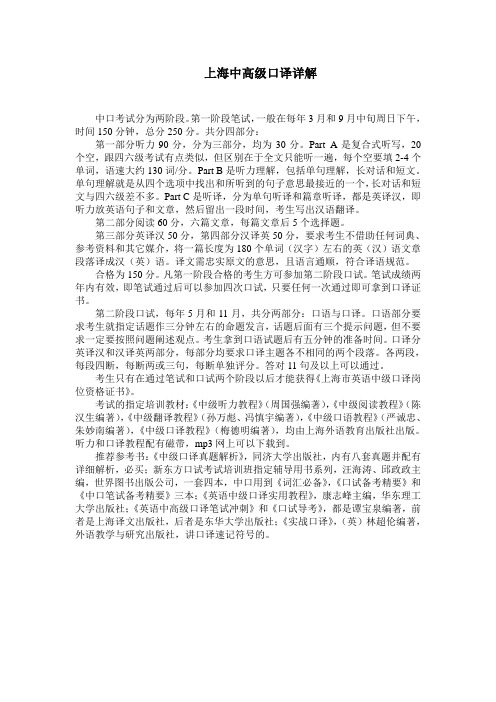
上海中高级口译详解中口考试分为两阶段。
第一阶段笔试,一般在每年3月和9月中旬周日下午,时间150分钟,总分250分。
共分四部分:第一部分听力90分,分为三部分,均为30分。
Part A是复合式听写,20个空,跟四六级考试有点类似,但区别在于全文只能听一遍,每个空要填2-4个单词,语速大约130词/分。
Part B是听力理解,包括单句理解,长对话和短文。
单句理解就是从四个选项中找出和所听到的句子意思最接近的一个,长对话和短文与四六级差不多。
Part C是听译,分为单句听译和篇章听译,都是英译汉,即听力放英语句子和文章,然后留出一段时间,考生写出汉语翻译。
第二部分阅读60分,六篇文章,每篇文章后5个选择题。
第三部分英译汉50分,第四部分汉译英50分,要求考生不借助任何词典、参考资料和其它媒介,将一篇长度为180个单词(汉字)左右的英(汉)语文章段落译成汉(英)语。
译文需忠实原文的意思,且语言通顺,符合译语规范。
合格为150分。
凡第一阶段合格的考生方可参加第二阶段口试。
笔试成绩两年内有效,即笔试通过后可以参加四次口试,只要任何一次通过即可拿到口译证书。
第二阶段口试,每年5月和11月,共分两部分:口语与口译。
口语部分要求考生就指定话题作三分钟左右的命题发言,话题后面有三个提示问题,但不要求一定要按照问题阐述观点。
考生拿到口语试题后有五分钟的准备时间。
口译分英译汉和汉译英两部分,每部分均要求口译主题各不相同的两个段落。
各两段,每段四断,每断两或三句,每断单独评分。
答对11句及以上可以通过。
考生只有在通过笔试和口试两个阶段以后才能获得《上海市英语中级口译岗位资格证书》。
考试的指定培训教材:《中级听力教程》(周国强编著),《中级阅读教程》(陈汉生编著),《中级翻译教程》(孙万彪、冯慎宇编著),《中级口语教程》(严诚忠、朱妙南编著),《中级口译教程》(梅德明编著),均由上海外语教育出版社出版。
听力和口译教程配有磁带,mp3网上可以下载到。
三个考试的区别:上海口译证书、教育部翻译证书和人事部翻译证书

上海口译证书、教育部翻译证书和人事部翻译证书这三个是现在比较热门的三大翻译考试类型,中高级口译已经日益普及,CATTI证书正在慢热中,其他诸如欧盟口译之类仍然属于高端、职业化的范畴,一般的语言学习者,应该选择哪一种证书呢?一起来看看三者的详细比较吧。
不同点考试设立机构人事部教育部上海市委组织部、人事局、教育局考试名称(中文)全国翻译专业资格(水平)考试全国外语翻译证书考试上海外语口译证书考试考试名称(英文)China Aptitude Test forTranslators andInterpreters -CATTINational AccreditationExaminations forTranslators and Interpreters-NAETI无考试设立时间2003年12月2001年11月1995年6月考试主办机构国家人事部和中国外文局联合举办教育部考试中心与北京外国语大学联合举办上海市委组织部人事部、教育部联合举办出题部门中国外文局北外和其它院校的著名学者,国际口译协会成员上海市委人事局评卷部门中国外文局北外和其它院校的著名学者,国际口译协会成员上海市委人事局发证机构国家人事部教育部考试中心和北京外国语大学联合颁发由中共上海市委组织部、上海市人事局、上海市教育委员会和上海市成人教育委员会统一颁发考核语种英、日、俄、德、法、西班牙、阿拉伯语(现已开设英、日、法语)英语英语、日语考试费用(北京地区04年11月)三级笔译考试费460元三级口译考试费630元二级笔译考试费550元二级口译考试费720元初级笔译考试费400元初级口译考试费500元中级笔译考试费600元中级口译考试费700元英高210元英中180元日语200元高级笔译考试费1200元高级口译考试费1200元考点设置2004年11月考点设置:英语口译“交替传译"考试试点城市为北京、天津、上海、重庆、武汉、广州、沈阳、哈尔滨、济南、南京、杭州、成都、昆明、长沙、兰州;英语笔译考试试点城市为北京、天津、上海、重庆、武汉、广州、沈阳、长春、哈尔滨、石家庄、西安、太原、呼和浩特、济南、南京、杭州、合肥、福州、郑州、成都、南宁、昆明、长沙、南昌、兰州。
上海中高级口译考试
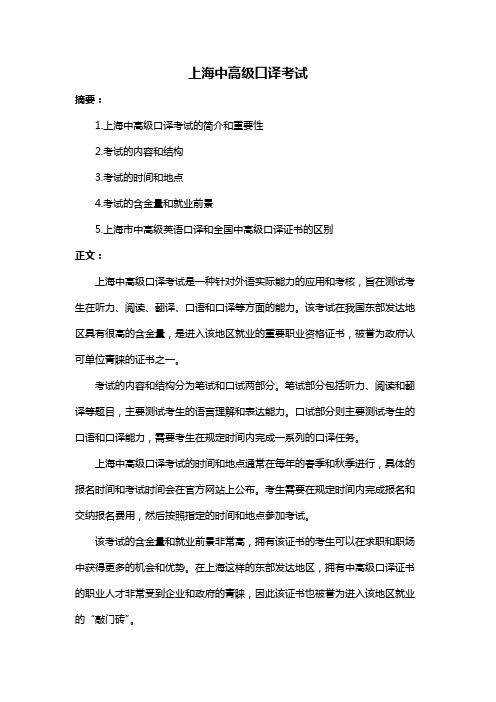
上海中高级口译考试
摘要:
1.上海中高级口译考试的简介和重要性
2.考试的内容和结构
3.考试的时间和地点
4.考试的含金量和就业前景
5.上海市中高级英语口译和全国中高级口译证书的区别
正文:
上海中高级口译考试是一种针对外语实际能力的应用和考核,旨在测试考生在听力、阅读、翻译、口语和口译等方面的能力。
该考试在我国东部发达地区具有很高的含金量,是进入该地区就业的重要职业资格证书,被誉为政府认可单位青睐的证书之一。
考试的内容和结构分为笔试和口试两部分。
笔试部分包括听力、阅读和翻译等题目,主要测试考生的语言理解和表达能力。
口试部分则主要测试考生的口语和口译能力,需要考生在规定时间内完成一系列的口译任务。
上海中高级口译考试的时间和地点通常在每年的春季和秋季进行,具体的报名时间和考试时间会在官方网站上公布。
考生需要在规定时间内完成报名和交纳报名费用,然后按照指定的时间和地点参加考试。
该考试的含金量和就业前景非常高,拥有该证书的考生可以在求职和职场中获得更多的机会和优势。
在上海这样的东部发达地区,拥有中高级口译证书的职业人才非常受到企业和政府的青睐,因此该证书也被誉为进入该地区就业的“敲门砖”。
与其他地区的中高级口译证书相比,上海市中高级英语口译证书在考试内容、考试形式和含金量等方面都有所不同。
例如,上海市中高级英语口译证书更注重考生的实际应用能力,因此在口试部分会有更多的口译任务,需要考生在实际场景中完成口译工作。
- 1、下载文档前请自行甄别文档内容的完整性,平台不提供额外的编辑、内容补充、找答案等附加服务。
- 2、"仅部分预览"的文档,不可在线预览部分如存在完整性等问题,可反馈申请退款(可完整预览的文档不适用该条件!)。
- 3、如文档侵犯您的权益,请联系客服反馈,我们会尽快为您处理(人工客服工作时间:9:00-18:30)。
SECTION 4: LISTENING TEST (30 minutes)Part A: Note-taking and Gap-fillingDirections: In this part of the test you will hear a short talk. You will hear the talk only once. While listening to the talk, you may take notes no the important points so that you can have enough information to complete a gap filling task on a separate ANSWER BOOKLET. Youare required to write ONE word or figure only in each lank. You will not get your ANSWER BOOKLET until after you have listened to the talk.Advertising is important to companies because no company can make a ________(1) onany product unless it advertises it first in the ____________(2). There are three categories of media: print, broadcast and __________(3). The print media consist of newspapers and________(4). Newspaper ads can reach large numbers of people, but they are not very___________(5) or glamorous. Magazine advertisement allows a business to direct its ads to the people who are most ___________(6) in the product, but it can be very expensive. The broadcast media include __________(7) and television. Of all the media, television is the most dramatic. so television ads are easy to __________(8).What's more, almost everybody watches TV, and most TV programmes are broadcast_______(9). TV ads are viewed by millions of people all over the country. TV advertisement is enormously ___________(10).The most common direct medium is the __________(11). The advantage is that the ad goes directly in the ___________(12) customer's hands. But these ads are often calle d “________(13) mail”, and are thrown away without being ___________(14).Another direct medium is _____________(15), those huge signs on the street. The messageon billboards is ____________(16), but it has to be very _________(17). The third type of direct medium is signs and ____________(18), which are usually used in point of purchase advertising and can be found in ______________(19) and shop windows. The advantage is that they are______________(20).Part B: Listening and TranslationⅠSentence TranslationDirections: In this part of the test, you will hear 5 English sentences. You will hear the sentences only once. After you have heard each sentence, translate it into Chinese and write your version in the corresponding space in your ANSWER BOOKLET.(1)___________________________________________________________________________ _____________________________________________________________________________ (2)___________________________________________________________________________ _____________________________________________________________________________ (3)___________________________________________________________________________ _____________________________________________________________________________ (4)___________________________________________________________________________ _____________________________________________________________________________ (5)___________________________________________________________________________ _____________________________________________________________________________ Ⅱ. Passage TranslationDirections: In this part of the test, you will hear 2 English passages. You will hear the passages only once. After you have heard each passage, translate it into Chinese and write you version inthe corresponding space in your ANSWER BOOKLET. You may take notes while you are listening.(1)___________________________________________________________________________ _____________________________________________________________________________ _____________________________________________________________________________ _____________________________________________________________________________ _____________________________________________________________________________ _____________________________________________________________________________ _____________________________________________________________________________ _________(2)___________________________________________________________________________ _____________________________________________________________________________ _____________________________________________________________________________ _____________________________________________________________________________ _____________________________________________________________________________ _____________________________________________________________________________ _____________________________________________________________________________ _________SECTION 5: READING TEST (30 minutes)Directions: Read the following passages and then answer INCOMPLETE SENTENCES the questions which follow each passage. Use only information from the passage you have just read and write your answer in the corresponding space in your ANSWER BOOKLET.Questions 1~3A “Campaign for Real Braille” has been set up after pl ans to introduce capital letters intothe braille alphabet have split the blind community.The Braille Authority of the United Kingdom (BAUK) has announced that by 2000it is introducing capital letters into a code which has previously only used lower-case characters. Supporters say that it is necessary because of the increasing use of capitals as abbreviations,as well as their use in e-mail addresses. It will also bring the UK in line with otherEnglish-speaking countries.But opponents, such as Sara Morgan, the 25-year-old founder of the campaign, argue it will push up costs and make books more cumbersome. “There aren't many industries where they actively make costs go up,” she said. “What I think in particularly ironic, though, is the factthis is going to come in at the same time as the Disability Discrimination Act. So, just as we're asking restaurants to provide braille menus we're making it more expensive to do so.”Braille, devised by Louis Braille in the 19th century is based upon a system of six raiseddots arranged to represent each character in the alphabet and several short-form words. Around 12,000 people use braille in this country.BAUK said that it took the decision to go-ahead with plans to introduce capitals after a questionnaire completed by 1,200 braille readers showed that a majority was in favour of change.The secretary of BAUK, Stephen Phippen, said: “The reason the decision was made wason the basis of the questionnaire, answered by individual members, not on what BAUK thought.”Overall 46 per cent of people were in favour of introducing a capital letter sign wherever a capital letter appears in print and just under 30 per cent were against. Among the respondents classing themselves as visually impaired (those who have some ability to read by sight) it was more popular compared to those who can read braille only by touch.Ms Morgan said the figures showed “there wasn't even a majority”. But Mr. Phippen said:“Those in favour were more or less 50 per cent. Those against were roughly half that. So twice as many people are in favour as against.”A spokesman for the National Library for the Blind said a survey done by it in 1994/5found readers were not in favour. The results of the BAUK survey however convinced them, and a spokesman said the y would implement the change.“We recognise there are advantages and disadvantages and we shall be working with our readers to help them understand how this symbol will operate,” he said.The introduction of capital letters is projected to take place by the end of 1999.“There are pros and cons,” admits Mr. Phippen. “But it should be noted that we are theonly English speaking country which has not yet introduced capital letters and of all the other countries which have not one has regretted it and tried to move back.”However Ms Morgan added: “We are determined to fight it all the way. They have got tostop trampling over people's rights.”1. Give a brief introduction of Braille system.2. What is the major issue discussed in the passage?3. what can be learned from Mr. Phippen's talk?Questions 4~6Modern woman may be better educated, have a better job and earn more money than her grandmother ever dream of, but in one way he life remains the same—eight out of ten women still do the household chores.Only 1 per cent of men say they do the washing and ironing or decide what to have for dinner. The only area where average man is more likely to help out is with small repairs around the house.The report Social Focus on Women and Men, by the Office for National Statistics, foundthat attitudes to women working have changed drastically over the past decade. Whereas in 1987 more than half of men and 40 per cent of women agreed with the statement, “A husband's job is to earn the money, a wife's job is to look after th e home and family”, that view had halved among both sexes by 1994.The numbers agreeing strongly with the statement, “A job is all right but what mostwomen really want is a home and children”, had also halved from 15 pre cent to 7 per cent of men feeling that way and 12 per cent to5 per cent of women.Women's increased participation in the world of work has been one of the most striking features of recent decades. Nearly half of all women aged 55 to 59 have no qualifications. But their granddaughters are outperforming their male peers across the board, and from1989overtook boys at A-levels.Gender stereotypes persist at this level of education, however, with more than three-fifths of English entrants being female, wile a similar proportion of maths entrants are male. A greater number of boys take physics and chemistry whereas girls predominate in social sciences and history.The explosion in higher education means there was a 66 per cent increase in number offemale undergraduates and a 50 per cent increase in the number of male undergraduates between 1990-91 and 1995-96.Women are also making breakthroughs in specific are4as of employment. Women nowform a slight majority among new solicitors although they make up only one-third of all solicitors. Since 1984 the number of women in work has risen by 20 per cent to 10.5 million. But when it comes to pay, they still lag behind their male peers. Women earn on average 80per of what men do per hour. They are also far more likely to work part-time or with temporary contracts.Part of the reason for this is because women still take the main role in childcare, althoughthey are more likely to work than in the past. The number of mothers with children under five doubled between 1973 and 1996. And the number of women who return to work within nine to eleven months of the birth increased dramatically. In 1974, only 24 per cent of women returned in this period compared with 67 per cent in 1996.The relationship between the sexes has also seen changes. Seven in ten first marriages arenow preceded by cohabitation compared with only one in twenty first marriages in themid-1960s. Since 1992 women in their early thirties have been more likely to give birth than those in their early twenties, although the fertility rate is still highest among those aged 25 to 29.4. What is the theme of the passage?5. What are gender stereotypes? List the gender stereotypes at the level of higher education discussed in the passage.6. What are the major changes concerning the status of women in Britain?Questions 7~10A new form of cloning to provide every baby with an embryonic “twin”, from which spare body parts could be grown and life threatening diseases treated is expected to be approved within weeks by senior government advisers on medical ethics.If their report is accepted by ministers, it would mean that Britain—which 20 years ago pioneered the test tube baby and last year produced Dolly, the world's first cloned mammal—could be the first to clone a human embryo.A working party from the Human Fertilisation and Embryology Authority (HFEA) and the Human Genetics Advisory Commission is expected to come down firmly against reproductive cloning, the process of replicating a living human being. It is expected to recommend government support of so called stem cells, stem cells, are extracted and used to grow spare parts, treat diseases such as Alzheimer's and Parkinson's or address the debilitating effects of cancer, strokes and heart attacks.Dr. Austin Smith, the scientist likely to be granted the first licence for the work, said thatwithin the next 12 years it would be routine for every baby to have an embryonic clone.“All it takes now is financial investment,” said Smith, director of Edinburgh University's centre for genome research. The crucial discovery of embryonic stem cells, from which skin, bone. muscles, nerves and vital organs grow, was made earlier this month by scientists in America.In a submission to the HFEA, Smith said that in order to isolate these cells it is only necessary for the embryo to develop in the laboratory for six days, well within the 14-day limit of current regulation.The cells would then be grown and manipulated to make anything from blood or brain cellsto tissue for repairing damaged organs and, ultimately, parts that could be transplanted without fear of the host body rejecting them.The development is likely to meet strong opposition from the church. Dr. Donald Bruce, creating an embryo in the knowledge that it would then be destroyed was “very disturbing” to most people.Father Paul Murray, secretary to the Catholic bishops joint bio-ethics committee, said that whatever the potential benefits, it should be regarded as “intrinsically evil” because the research depended on the use of foetal material.However, Professor Christine Gosden, professor of genetic medicine at Liverpool University, one of the four senior government advisers on the cloning sub-committee, said there would be no opportunity for abuse.For many years, patients with Parkinson's disease who did not respond to drugs have been treated with brain cells extracted from aborted foetuses, a practice approved by a committee led by the Rev Dr. John Polkinghorne, the prominent ethicist.Gosden said the arguments for the use of aborted foetal cells and therapeutic cloning were similar: “Before you have a disease, it is easy to say, ‘I would not use cells derived from a foetus’, but if you suffer from that disease, and that is your only hope, your approach can be quite different.”7. What is the new form of cloning discussed in the passage? What is the purpose of such cloning?8. Summarise the different views on baby cloning discussed in the passage.9. Explain the statement “All it takes now is financial investment.” (para.6)10. What is the significance of the discovery of embryonic stem cells?SECTION 6: TRANSLATION TEST (30 minutes)Directions: Translate the following passage into English and write your version in the corresponding space in your ANSWER BOOKLET.十月的上海,阳光明媚,秋高气爽,来自35 个国家和地区的1300余名比赛选手参加了在沪举行的本世纪最后一届世界中学生运动会。
